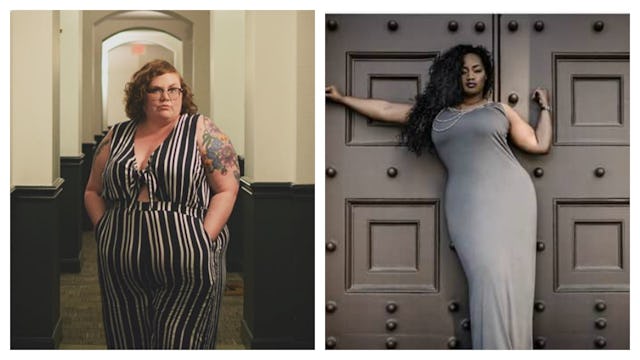#Whatfatgirlsreallywear Is Trending, And We're So Here For It

Start here: stick it on a shelf. We don’t want to hear your comments about “glorifying obesity.” We don’t want to hear your mock-concern about our health. We don’t want to hear how we look “nasty” or “need to put some clothes on” or how “no one wants to see that.” Because #whatfatgirlsactuallywear is here to stay (and slay).
And your approval or permission is not necessary or desired.
We believe in Health at Every Size. We believe every body is a bikini body. We believe you are beautiful, that you should love your own fierce self, at whatever size you’re at.
So women started hashtagging #whatfatgirlsactuallywear. Basically, take a look in my closet, bitches. This is what I walk around in. This is what I can wear: i.e., everything. This is what I give myself permission to wear, a permission society says I should deny myself. Instead, I wear whatever the hell I damn well please. With over 80,000 tags and counting, #whatfatgirlsactuallywear is popular with plus-sized models and average-sized women alike, and it’s inspiring and empowering.
https://www.instagram.com/p/Bl3OA2fFrtj/?tagged=whatfatgirlsactuallywear
Let’s start with the word: fat. There’s a nebula-sized cloud of negativity surrounding the word “fat.” But fat, these women argue, is just a word. It’s not a judgment. It’s not a feeling: You can’t feel fat. You can feel as if you ate too much, you can feel as if you dislike your body, but these are not “feeling fat.” Fat is a description of a body larger than what society terms the norm (though with the average American women hitting a size 16, you’d have to argue that fat is the norm, not the other way around).
As @chubbystruggles says, “I try to own the word fat, taking away the power it holds as a negative term and using it as what it was meant to be: just an adjective.”
Boom. Done. “Just an adjective.”
But #whatfatgirlsactuallywear does more than just reclaim the word fat. As the stunning @fullfiguredfierce, AKA Dionne Reeves-Grubbs, founder of Full Figured Fierce, says, it’s “a look into our Plus size closets. The plus community is surrounded by myths and assumptions about what we eat, wear, how we are loved to how we make love and any other COMPLETELY normal things ‘standard’ size people do.” The hashtag pulls back the curtains — which we’re not wearing, by the way, no matter what people might expect. As Instagrammer @chubbystruggles said to Scary Mommy, “it brings the body positive movement into the everyday life.”
And we are so here for it.
Instagrammer @fullfiguredfierce says that when she hashtags #whatfatgirlsactuallywear, she shows men and women “images of Plus Size men and women living their LIVES, not hiding in their bedrooms for fear of ridicule.”
This is what #whatfatgirlsactuallywear really boils down to: the reality of big, beautiful women stepping out and living their best lives, regardless of what others tell them, regardless of what society says, regardless of what slurs and bullying they may have grown up with.
#whatfatgirlsactuallywear is not all evening gowns and fancy clothes, either: I opened my Instagram this morning to see @round2it kitted out in a gorgeous wrap dress from Marshall’s. It’s real women. It’s real life. It’s real people telling the rest of the world to fuck off, because this is who they are and they are fierce, fabulous, and beautiful.
“I wear what I like,” @fullfiguredfierce says, “not what society ASSUMES I should wear, i.e. prints that look like our grandmother’s old couch or curtains, unflattering cuts AKA tents, to hide our size… I make the clothes, not the other way around.”
Amen, sister. We all need to walk out into life with this kind of confidence: fat or thin, straight or gay, supermodel or not: this is us. This can be us. We just have to reach out and claim it. Amen to the women who walk the walk and talk the talk. Amen the to sisters paving the way.
Wanna share? Hashtag #whatfatgirlsactuallywear and tag @scarymommy. We want to see your gorgeous outfits — and your gorgeous bodies!
SaveSave
This article was originally published on